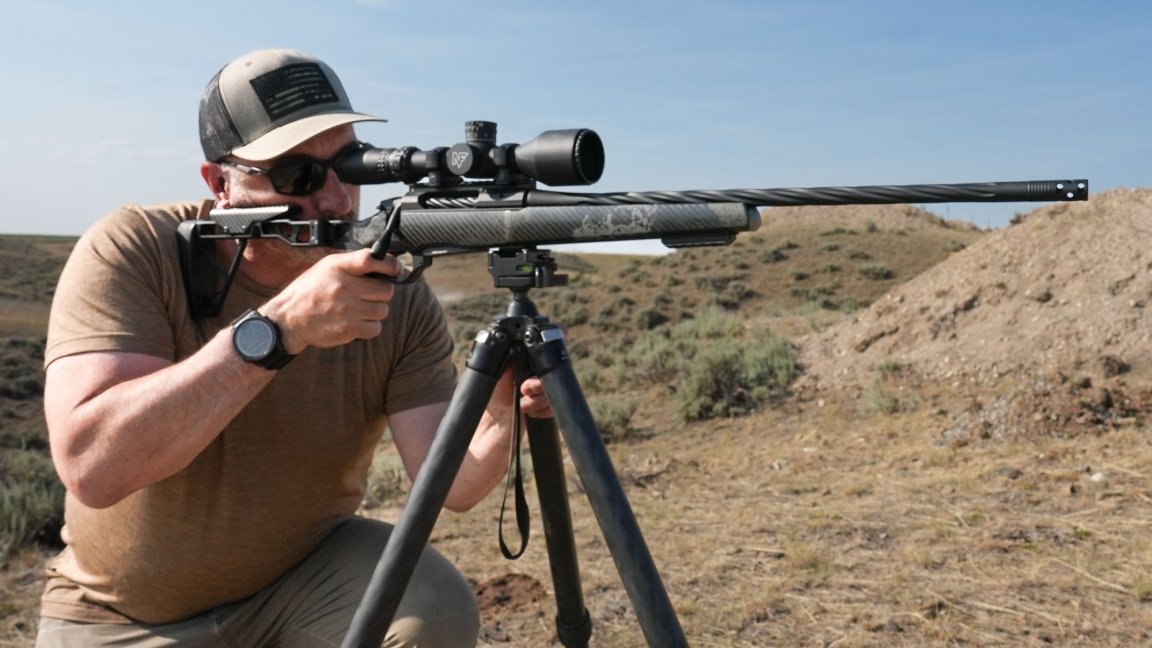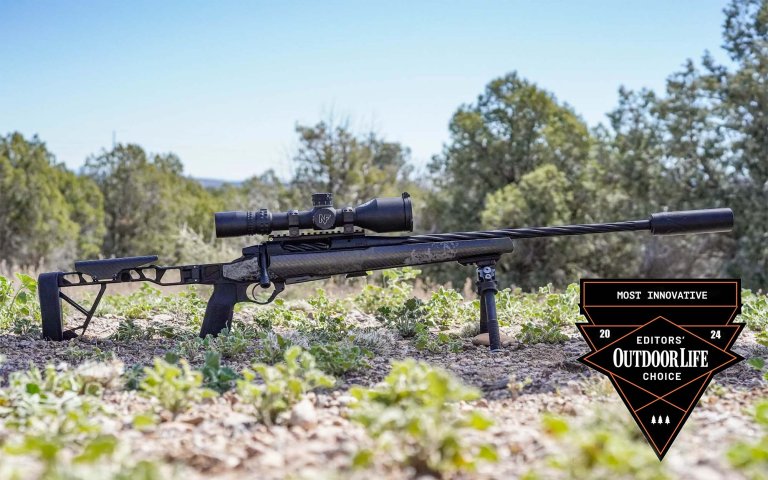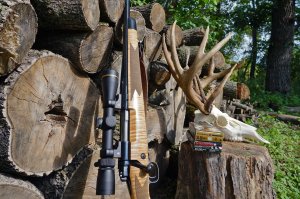We may earn revenue from the products available on this page and participate in affiliate programs. Learn More ›
When it comes to packable mountain rifles, the Seekins Havak Slam is the most refined and feature-rich in this expanding field. This svelte creation incorporates innovative elements while avoiding excess, and is as enjoyable to shoot at the range as it is to haul on your back.
I’ve spent several months with two examples of the Slam, one in 6.5 PRC and the other in 6.5 Creedmoor, and have come away pleased by both. I’m not alone in this. The panel of judges on Outdoor Life’s gun test team shared these sentiments, and that’s how the Havak Slam earned an Innovation Award at this year’s rifle test.
Seekins Havak Slam Specs
- Action: Four-lug bolt-action (two rows of two)
- Stock: Carbon-fiber folder with aluminum bedding chassis
- Cartridge: 6.5 Creedmoor (tested)
- Capacity: 3+1
- Weight: 5 pounds 9 ounces (measured)
- Trigger: TriggerTech Diamond, 1 pound 15 ounces (measured)
- Barrel: 20 inches; 1:8 twist, threaded 5/8-24
- Length: 42.25 inches (32.5 inches folded)
- Price: $4,650
Key Features
- Integral 20 MOA Pic rail with bubble level
- Folding carbon-fiber chassis stock
- Available in short and long action lengths
Review Highlights
- Ultralight rifle is stiff and stable
- Delivered good accuracy
- Excellent ergonomics and design


Seekins Havak Slam Accuracy
We’ve put more than 50 five-shot groups through the Slam to date to assess its accuracy. The overall average of those groups was 1.25 inches, which is very good performance from such a large sample size across 12 different types of ammo.
Looking at 20-shot groups with certain types of ammunition, the Seekins Slam printed extreme spreads of 1.19 to 1.6 inches. One load that performed particularly well was SigSauer 140-grain HPBT, which had 20-shot mean radius values of .33 to .36 inches.
A Featherweight Marvel
Technically, any rifle you haul up a mountain on a hunt is a “mountain rifle.” By that standard, I’ve lugged some 8-pound mountain rifles around in my time — and that’s before you account for the scope.
Generally speaking though, once a rifle trims its weight to 6.5 pounds or less, it can legitimately be considered a mountain rifle, and those under six pounds naked are true ultralights. We’ve reviewed a lot of great mountain rifles over the years, and now we’re adding the Seekins Havak Slam to the roster.
This rifle weighs 5 pounds 9 ounces unscoped and that, combined with how neatly it tucks away when the stock is folded, makes it tremendously appealing for chasing sheep, mountain goats, or any other critter that lurks at high altitude.
To get down to 5.5 pounds, Seekins had to take a minimalistic approach to every component. I was curious to see how different elements on the rifle measured up.

Seekins Havak Slam Component Weights
- Barreled Action: 3 pounds (sans bolt and brake)
- Stock: 1 pounds 14.6 ounces
- Bolt: 7.8 ounces
- Magazine: 1.8 ounces
- Muzzle Brake: 1.0 ounces
A few things stood out while weighing the bits and pieces. It should be noted that the rifle uses a full-body diameter bolt with two rows of two lugs. Normally that would add heft, but at less than half a pound it is still a remarkable design.
The magazine is just a wisp of a carbon-fiber shell that looks like it was fashioned for Formula 1 racing rather than a hunting rifle. It is a cool design that Seekins created years ago for their earlier Havak rifles and is surprisingly tough and durable despite its featherlight construction.
Creating a lightweight stock is one thing. But to have a stock that’s under two pounds that folds, has an adjustable cheek piece, incorporates an aluminum bedding block and insert in the fore-end for M-Lok accessories, and that comes with attached aluminum Pic rail and ARCA rail segments is just remarkable.
Of course, the barrel is turned down to a slender profile and has spiral fluting (that looks pretty baller, I might add) to reduce weight and the receiver is made from aluminum. One of the cooler weight-saving details on the action is how Seekins machined out the tops of each of the rails on the 20 MOA Picatinny rail that runs the length of the action. I don’t know how much weight that accounts for, but as mountain climbers like to point out, grams become ounces and ounces become pounds.

Mountain Calibers
What are the best calibers for mountain hunting? Back in the day, hunters gravitated toward the .30-caliber magnums such as the .300 Weatherby Magnum, .300 Winchester Magnum, and others.
Of course, back in the day, those rifles would have a hard time shooting under 1.5 inches at 100 yards with perfect conditions off a bench with five-shot groups. In the field, they’d do even worse. Even in regular sporter-weight rifles many (if not most) hunters have a hard time coping with magnum recoil.
No doubt someone will bark at me about their ½-MOA magnum-caliber ultralight gun and make no mistake about it — I couldn’t be happier for you. Whether it actually shoots that well, particularly when judged by more exacting (and meaningful) standards is another issue. I’ll believe it when I see it.
As we’ve become more savvy about cartridge design and its relation to interior, exterior, and terminal ballistics, we’ve learned that less is more — often a lot more. With that in mind, cartridges like the 6mm Creedmoor, 6.5 PRC, 6.5 Creedmoor, 6.8 Western, and others have gained favor with open-country hunters.
One experienced guide I know who specializes in high-dollar hunts for Asian wild sheep, ibex, and other game wishes all his clients would come with the often-maligned 6.5 Creedmoor, because he knows they would shoot better and more quickly anchor their game compared to historically popular magnums.

Seekins Havak Slam Cartridge Offerings
Glen Seekins is well aware of the tradeoff between a light rifle and cartridge size, and with that in mind he’s introduced the Havak Slam in .308 Win., 6.5 PRC, and 7 PRC, in addition to producing a smaller run of Slams in 6.5 Creedmoor.
By his own admission the 7 PRC pushes the shootability of the platform. Even with the effective radial muzzle brake the rifle ships with, launching those heavy .284-caliber bullets at 2900 to 3000 fps becomes a chore after a few trigger pulls.
In .308 Win., the rifle comes with a 16-inch barrel. The 6.5 PRC version has a 21-inch barrel, and the 7 PRC has a 22-inch tube. The barrel on my 6.5 Creed is 20 inches.
Shooting the Seekins Havak Slam
I split my time shooting the Slam with the brake affixed and with a suppressor attached to get a feel for how it behaves in stock trim and how it works with a can, which is how I intend to hunt with it this fall. I really like how well the rifle runs in 6.5 Creedmoor and slightly preferred it over the 6.5 PRC, though both were pleasant. Since it’s a bit milder, the Creed seemed to pair better with the Slam and was a touch easier to manage.
Both rifles hold three rounds in the magazine and can be loaded with one extra in the chamber if desired.

An Excellent Butt Stock
The hinge on the folding stock is remarkably stiff and locks open without a hint of wiggle or give. The Slam mounts a generously sized recoil pad on the butt, which otherwise is skeletonized and minimalistic, though it does also include a QD attachment point, as does the fore-end.
Between the pad, the smooth carbon fiber cheekpiece, and the skeletonized frame, the butt offers a surprising amount of control over the rifle. Using a rear shooting bag, I could hook a thumb through the frame and really snug the rifle into my shoulder for effective, consistent shooting. Once I figured out that technique, my groups tightened noticeably.
The rifle comes with a simple AR-15 style pistol grip made by B5: their P-Grip 22. It is minimalistic and incorporates good texture on the sides and front for all-weather traction. It positions the shooting hand in good relation to the flat-faced trigger and I found I shot equally well with my thumb alongside the grip as with my hand wrapped around it.
Adjusting the Rifle
The rifle doesn’t have a ton of adjustability built into it, but you can raise or lower the cheekpiece a bit. The excellent TriggerTech Diamond trigger the rifle ships with can be tuned as well.
I don’t know if it was intentional, but you can look underneath the taco-shaped cheekpiece while bore sighting the rifle, which made zeroing it go that much more quickly.

Reliability and Basic Operation
The good news here is that there isn’t much to report. The magazine loads easily, clicks into place in a positive manner, and — because of how the lugs orient in the action (they are at 6 and 12 o’clock when running the bolt) — the bottom lug has a lot of area to engage the top round in the magazine for reliable feeding.
The bolt has an AR-15 type extractor at the 10:30 o’clock position, and a plunger ejector at 4 o’clock. Both worked perfectly.
The TriggerTech Diamond incorporates a standard two-position Remington 700 safety that is positive and easy to manipulate — another basic and straightforward feature on the rifle.
Cycling and Fouling
The Slam has a 90-degree bolt throw, and the full-diameter bolt body runs easily in the raceway. The anodized aluminum action isn’t as slick as some steel actions can be, but it is smooth enough and whenever it would start to get gummy from fouling a quick wipe with solvent or gun oil would remedy the issue.
(Though the receiver is aluminum, it contains a steel sleeve where the lug recesses go in order to handle the pressures generated by the cartridges.)
Positional Shooting
The Seekins Slam brings a lot to the party when it comes to running it in practical shooting situations. The pistol grip, the trim fore-end with a flat bottom, the ease with which you can attach a high-quality bipod, and the clever ARCA rail section (which is turned 90 degrees so it doesn’t protrude from the sides) give the shooter a lot of options.
I’ve run the rifle clipped into a tripod, off a basic shooting bag from rocks and other terrain features, off a tac table/tripod combo, and prone with bipod and rear bag.
I found the rifle easy to manage and shoot accurately during all these scenarios. It doesn’t have anything extraneous hanging from it that can get caught in vegetation, the stiff stock and pistol grip afford a lot of control, and it is light and nimble to maneuver.
One other bonus in the rifle’s design is the bubble level that’s integrated into the rear of the Picatinny rail. That’s a really useful feature so you can double check your rifle’s orientation before dropping the hammer on a target — whether it’s a piece of distant steel or the mule deer of your dreams.
My One Gripe: The Magazine Release
This is a well thought out rifle from muzzle to butt. And while I really like the idea of the magazine release on this rifle — it’s elegantly incorporated into trigger guard — I have one concern in terms of its practical use.
To get to the release I have to hook a finger inside the trigger guard and when doing so the finger would sometimes contact the trigger. A couple times while manipulating the rifle during dry-fire practice that was enough to trip the sear. To avoid this, I’ve learned to be extra careful and deliberate when removing the magazine.
To be clear, neither I nor anyone else who handled the rifle during our evaluation had a negligent discharge — and neither will you if you observe basic firearms safety. But I would prefer a magazine release like the Mack Bros M5. The release is still incorporated into the trigger guard but you can manipulate it and drop a mag without putting a digit inside the guard.

Toolless Takedown
Having a bolt that easily comes apart and goes back together without tools is a major plus. And having that functionality in a true backcountry rifle is pretty much a requirement for me anymore.
A simple twist on the bolt shroud on the Seekins Havak Slam lets you remove the shroud and firing pin assembly. With the assembly removed, you can knock out the pin that retains the bolt head. Within seconds you can have the bolt in serviceable pieces — just keep track of that retaining pin, as that’s the one bit that could potentially get lost in the rocks on a mountain.

Solid Bedding System
Part of the reason for the Seekins Havak Slam’s accuracy is how the action and stock join. The foundation of the stock is an aluminum bedding block around which carbon fiber is laid. That bedding block is broad and flat at the front of the receiver and has a good sized flat at the back as well.
A raised rectangular lug is machined into the bedding block and that goes into a corresponding recess on the flat underside of the action. The action and bedding block also have flat angled sides that mate up too, giving additional support.
When the action and stock are placed together there isn’t an iota of movement between the two — even without either of the action screws threaded into place. It is an impressive, solid design.

Seekins Havak Slam Pros and Cons
There’s a lot to like about this rifle, and I’m not surprised to learn that avid mountain hunters (or those with the budget to pretend they are) have been snapping up these rifles.
Pros
- Lightweight, nimble, and accurate
- Folds down small enough to transport within a pack
- Optimized for practical field shooting
Cons
- Expensive
- Magazine release is awkward to manipulate
Final Thoughts on the Seekins Slam
It is certainly the best-executed pack rifle you can currently buy, assuming it is within your budget. And it is what I’ll be carrying in my pack this fall while hiking around for elk and deer in the backcountry.
This is a wonderful, though pricey, hunting rig. It sets a new highwater mark among ultralight mountain rifles in terms of its thoughtful design. It has an excellent feature set geared toward challenging shots in challenging terrain but avoids unnecessary frills.


